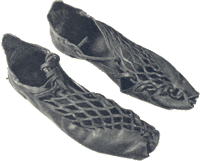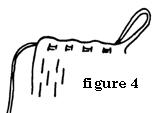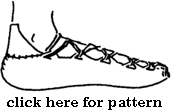 |
Latticework Shoes |
This pair of shoes was found in Damdorf Mose in modern Denmark and are probably from the late Iron Age. They are a primitive style of construction, being made primarily of one piece of material with a small inset at the heel. The use of lattice cuts on the vamp of the shoe allows it to be fairly elastic and comfortable. The lozenge
shapes are formed by stretching the leather over the foot.
To construct:
Adjust the pattern to your size and cut out as shown. The long strip will become the thong which laces the shoe together. It should be at least 27-28 inches long. Try to keep the lattice slits on the top of the shoe 1" long or under regardless of how much you increase the shoe size.
Seam the two flaps at the heel of the shoe together as shown in fig. 1, matching the dots. Now seam the bottom of the shoe to the flaps, gathering the material if necessary (fig.2). Sew the extra heel piece to the shoe as shown in fig. 3. Lace the thong cut on the front of the shoe through the front slits (fig. 4) and pull tight and secure.
Lace the remaining thong back and forth from the triangular holes to the outermost slits to form the top of the shoe.
Source:
Hald, Margarethe Primitive Shoes.The National Museum of Denmark, 1972.
Back to Early Period #5 |
Back to Early Period Index |
Back to PastTimes







